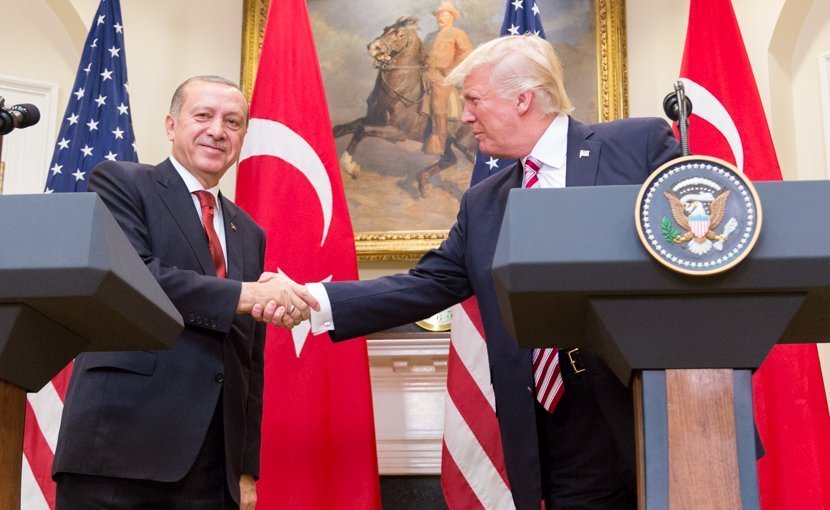File photo of US President Donald Trump and Turkey’s President Recep Erdoğan. Official White House Photo by Shealah Craighead.
Turkish troops and armored units are massed along Turkey’s southern border awaiting orders to invade northern Syria. Turkish President Recep Tayyip Erdogan wants to clear a ten mile-deep swath of land east of the Euphrates River in order to remove terrorist-linked militants (YPG) currently occupying the territory. The proposed offensive would put US Special Forces in the line of fire which significantly increases the likelihood of US casualties. If American troops are killed or wounded by the Turkish operation, Washington will respond in force leading to a potentially catastrophic face-off between the two NATO allies. The possibility of a violent clash between Turkey and the United States has never been greater than it is today.
On Wednesday, U.S. Secretary of State Mike Pompeo warned Turkey that any unilateral action in Syria would have “devastating consequences.” Pompeo’s comments were intended to intimidate Erdogan who stated on Tuesday that the military offensive would begin shortly after last weekend’s elections. If Erdogan proceeds with his plan, Pompeo will undoubtedly give the military the go-ahead for retaliatory attacks on the Turkish Army. This will either lead to a speedy retreat by Turkey or asymmetrical strikes on US strategic assets across the region. In any event, the fracas with Turkey is bound to widen the chasm between the two former allies forcing Erdogan to reconsider his commitment to the western alliance. Any further deterioration in relations between the US and Turkey could result in a dramatic shift in the global balance of power.
Washington’s problems with Erdogan began years before the current dust-up. The Turkish leader has always steered an independent foreign policy which has been a constant source of frustration for the White House. During the war in Iraq, Erdogan refused to allow the US to use Turkish air bases to conduct their operations. (Erdogan did not support the war.) Presently he is purchasing air defense systems from Russia (S-400), (which VP Mike Pence has strongly condemned), he has attended summits in Sochi with Moscow and Tehran in order to find a political settlement for the war in Syria, he has signed contracts with Gazprom that will make his country the energy hub of southern Europe, and he has been harshly critical of US support for the its Kurdish proxies in east Syria (the SDF) which is an offshoot of the Kurdish Workers Party (PKK), a group that is on the US State Department’s list of terrorist organizations.
Most of the friction between Erdogan and the US has been brought on by Washington’s flagrant disregard for Turkey’s security concerns. The current crisis is just another self inflicted wound, like the failed coup in 2016 which backfired spectacularly strengthening Erdogan’s grip on power while fueling widespread distrust of the United States. Check out this excerpt from an article in the New York Times dated August 2, 2016:
“A Turkish newspaper reported that an American academic and former State Department official had helped orchestrate a violent conspiracy to topple the Turkish government from a fancy hotel on an island in the Sea of Marmara, near Istanbul. The same newspaper, in a front-page headline, flat-out said the United States had tried to assassinate President Recep Tayyip Erdogan on the night of the failed coup.
When another pro-government newspaper asked Turks in a recent poll conducted on Twitter which part of the United States government had supported the coup plotters, the C.I.A. came in first, with 69 percent, and the White House was a distant second, with 20 percent.
These conspiracy theories are not the product of a few cranks on the fringes of Turkish society. Turkey may be a deeply polarized country, but one thing Turks across all segments of society — Islamists, secular people, liberals, nationalists — seem to have come together on is that the United States was somehow wrapped up in the failed coup, either directly or simply because the man widely suspected to be the leader of the conspiracy, the Muslim cleric Fethullah Gulen, lives in self-exile in the United States.” (Turks Can Agree on One Thing: U.S. Was Behind Failed Coup – The New York Times)
Let’s cut to the chase: Was the United States behind the plot to remove Erdogan from office in 2016?
Probably, just as the United States was behind more than 50 other regime change operations since the end of WW2.
And is the US currently harboring the mastermind of the Turkish junta in a sprawling compound in rural Pennsylvania?
Yes, this is probably true as well. But, even though Turkey has provided the US with mountains of evidence identifying Gulen as the coup-leader, and even though Turkey has cooperated in the extradition of numerous terror suspects sought by the United States, the US simply doesn’t feel any obligation to return the favor by treating Turkey with respect and fairness. Why is that? Why is there one standard for the United States and a completely different standard for everyone else?
Erdogan has repeatedly asked the Trump administration to respect Turkey’s legitimate security concerns by removing terrorist-linked militants (YPG) from the area around Turkey’s southern border. In mid December, Trump discussed the issue with Erdogan over the phone and agreed to meet the Turkish president’s requests. Four days later (December 19) Trump announced that all US troops would be withdrawn from Syria within 30 days. Since then, the administration has failed to meet any of its prior commitments. It has increased its troop levels in east Syria, bolstered its military hardware and weaponry, and reinforced its positions along the border.
The US has also failed to fulfill its obligations under the terms of the Manbij Roadmap which requires the US to remove all YPG fighters in and around the city and assist Turkey in establishing security in Manbij. There has been no movement on this front at all. If anything, the situation has gotten worse. This suggests that the Trump team has no intention of lifting a finger to address Turkey’s security concerns or of following through on its clearly stated commitments. It suggests that Washington is actually trying to provoke Erdogan in taking matters into his own hands and doing something that he might later regret.
While Ankara’s designs on Syrian territory have no legal basis, they have been consistently reiterated (without change) from the earliest days of the war. As far back as 2012, Turkey insisted on a “safe zone” which would establish a buffer between itself and YPG militants operating in east Syria. The Obama administration agreed to assist Erdogan in the creation of a safe zone in exchange for the use of the strategically-located airbase at Incirlik. Here’s a clip from another article at the New York Times dated July 27, 2015 which explains:
“Turkey and the United States have agreed in general terms on a plan that envisions American warplanes, Syrian insurgents and Turkish forces working together to sweep Islamic State militants from a 60-mile-long strip of northern Syria along the Turkish border, American and Turkish officials say.
The plan would create what officials from both countries are calling an Islamic State-free zone controlled by relatively moderate Syrian insurgents, which the Turks say could also be a “safe zone” for displaced Syrians.
While many details have yet to be determined, including how deep the strip would extend into Syria, the plan would significantly intensify American and Turkish military action against Islamic State militants in the country, as well as the United States’ coordination with Syrian insurgents on the ground. …
“Details remain to be worked out, but what we are talking about with Turkey is cooperating to support partners on the ground in northern Syria who are countering ISIL,” a senior Obama administration official said, using another term for the Islamic State. “The goal is to establish an ISIL-free zone and ensure greater security and stability along Turkey’s border with Syria.” (“Turkey and U.S. Plan to Create Syria ‘Safe Zone’ Free of ISIS”, New York Times)
Repeat: “Turkey and the United States have agreed in general terms on a …safe zone” In exchange, the US would be allowed to use the Incirlik airbase. This is the deal that Obama made with Erdogan, but the United States never kept up its end of the bargain. Of course, the facts related to Incirlik have been swept down the memory hole in order to demonize Erdogan and make it look like he is the one creating all the problems. But that’s simply not the case. It wasn’t Erdogan who scotched the safe-zone deal, it was Obama.
By the way, the announcement that Turkey had struck a deal with Obama on Incirlik turned out to be the trigger for Russia’s entry into the war. This little known fact has escaped the attention of historians and analysts alike, but the truth is clear to see. Shortly after the above article was published (July 27, 2015), Russia began hastily clearing airfields and shipping its warplanes to Syria. Two months later, Russia began its momentous air campaign across Syria.
Why the hurry?
Mainly because of the information that appeared in the NY Times article, particularly this:
“Turkish officials and Syrian opposition leaders are describing the agreement as something just short of a prize they have long sought as a tool against Mr. Assad: a no-fly zone in Syria near the Turkish border.”
“No-fly zone”? Is that what Obama had up his sleeve?
Once Putin realized that the US was going to use Incirlik to establish a no-fly zone over Syria, (the same way it had in Libya) the Russian president quickly swung into action. He could not allow another secular Arab leader to be toppled while the country was plunged into chaos. This is why Russia intervened.
What Trump’s Neocons Want
So now Turkey and the United States are at loggerheads, the Turkish Army has completed its preparations for a cross-border operation east of the Euphrates, while Pompeo, Bolton and Pence continue to exacerbate the situation by issuing one belligerent statement after the other.
Is this the administration’s strategy, to lure Turkey into a conflict that will force Washington to get more deeply involved in the Middle East? Is that why the US has shrugged off its commitments to Ankara, dug in along the border, created a Kurdish state at the center of the Arab world, and is now thumbing its nose at Erdogan?
What is it the neocons (Pompeo, Bolton and Pence) really want?
They want to intensify and expand the fighting so that more US troops and weaponry are required. They want a wider war that forces Trump to go “all in” and deepen his commitment to regional domination. They want America’s armed forces to be bogged down in an unwinnable war that drags on for decades and stretches across borders into Lebanon, Turkey and Iran. They want Washington to redraw the map of the Middle East in a way that diminishes rivals and strengthens Israel’s regional hegemony. They want more conflagrations, more bloodletting, and more war.
That’s what the neocons want, and that’s what their provocations are designed to achieve.
By Mike Whitney
Source: Eurasia Review



